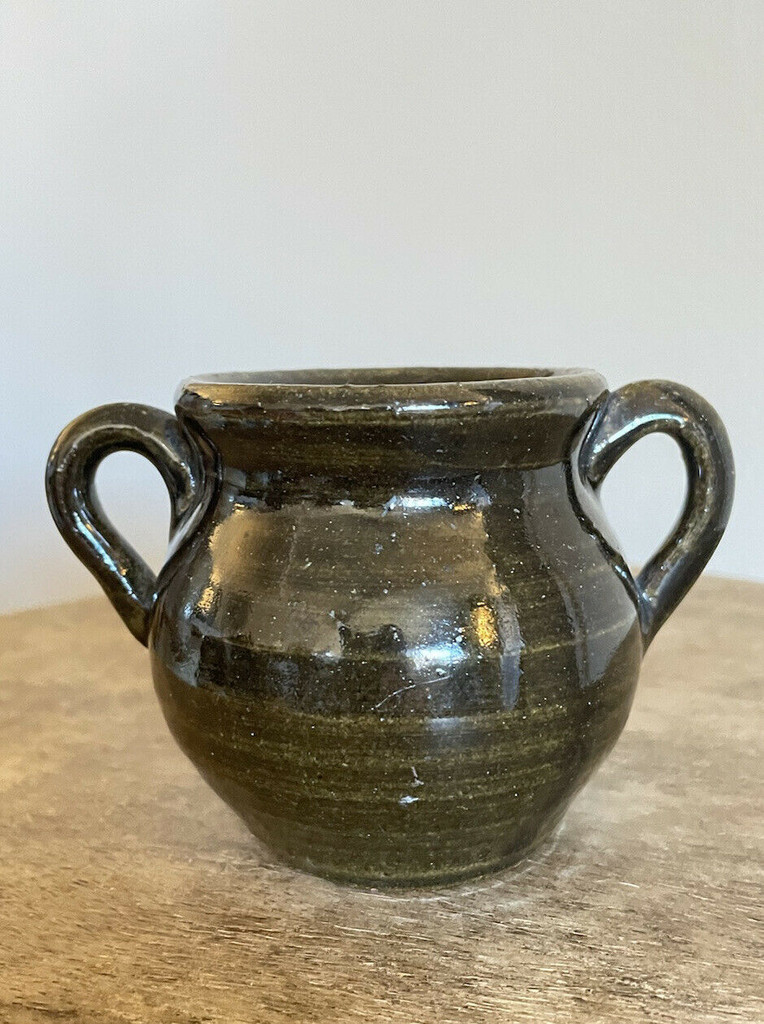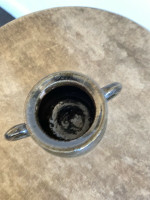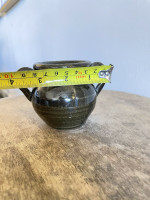Lanier Meaders Dark Green Mini Double Handle Jug Stoneware
Great condition all around. It looks as though there is a little glaze missing from a spot on the interior which is visible in the images.
There is no doubt Lanier Meaders is the most famous folk potter in the United States. He is the third son of Aire and Cheever Meaders. Lanier can be credited with single-handedly keeping Southern folk pottery from all but dying with his distinct style and sculptural creativity. These qualities are best evidenced in Lanier’s one-of-a kind face jugs, without which no Southern folk pottery collection is complete.
Lanier's dedication to Southern folk pottery has not gone unnoticed. Meaders face jugs, being sought after by collectors everywhere, are a featured exhibit in the Smithsonian Institute and other museums around the country. Lanier along with his mother Arie Meaders, was honored by the Library of Congress with a Meaders Pottery Day in 1978. In 1983, Lanier was awarded the National Heritage Fellowship by the National Endowment for the Arts and in 1987 he received the Governor’s Award for the Arts in Georgia. Lanier has received numerous other recognitions and awards.
Lanier Meaders continued the traditional ceramic craftsmanship in White County, Georgia, where stoneware was possibly in production as early as 1820. His grandfather, John Milton Meaders, opened the Meaders Pottery in 1893, employing his sons, Wiley, Caulder, Cleater, Cheever, and Casey, to assist hired local potters. Through these men the Meaders learned the basic techniques employed by Mossy Creek potters for over half a century—knowledge that passed to Lanier when his father, Cheever, took over the original family shop in 1920. By 1930, the Meaders were the last of the family potteries in Mossy Creek.
When a Doris Ullman photograph of Cheever and his family was published in Allen Eaton Handicrafts of the Southern Highlands in the late 1930s, the demand for Meaders stoneware significantly changed from utilitarian wares to whimsies such as face jugs. Lanier became a full-time potter after his father’s death in 1967, initially producing an order of face jugs for the Smithsonian Institution’s first Festival of American Folklife. Although he continues to make household stoneware, these face jugs are now his specialty.
Lynda Roscoe Hartigan Made with Passion: The Hemphill Folk Art Collection in the National Museum of American Art (Washington, D.C. and London: National Museum of American Art with the Smithsonian Institution Press, 1990)
Quillan Lanier Meaders grew up working with clay but didn’t get the “bug” until he was fifty. He admitted to making “more than 1 and less than 50,000” face jugs during his career, using the same equipment, clay, and glazes as his father and grandfather before him (The News and Observer, North Carolina, 1993).
Customer Reviews Write a Review
Sorry, there are no reviews for this product yet.
























